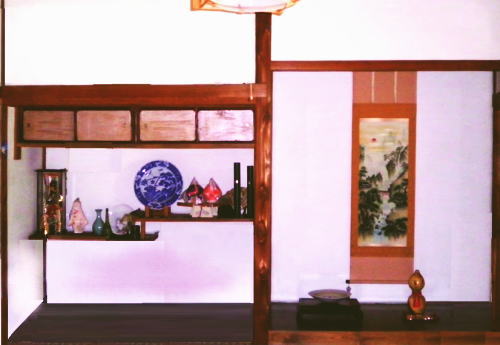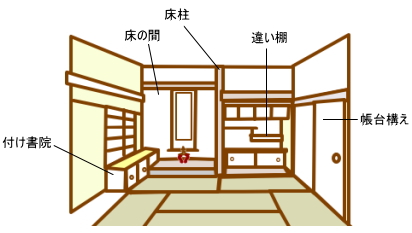Last update June 8, 2021
観光用語解説
書院造り (しょいんづくり)
Shoin (Samurai-residence style; traditional Japanese house style)
 平安時代の貴族の家の様式が「寝殿造り」。そして、それまでブイブイいわせてた藤原氏の勢力が衰えて、武士が政権を握るようになると、寝殿造りを真似して、簡略化したのが「書院造り」なのね。
平安時代の貴族の家の様式が「寝殿造り」。そして、それまでブイブイいわせてた藤原氏の勢力が衰えて、武士が政権を握るようになると、寝殿造りを真似して、簡略化したのが「書院造り」なのね。
 「書院」がどういう意味かって言えば、「書斎」ってところじゃない?もともとは、お坊さんが朝に夕に仏さまを拝んだり、経典を読んだり、お線香をあげたり、日常生活していた部屋のことを「書院」って言ったらしいわ。つまり、それが書院造りの語源。それがだんだん、庶民の間にも浸透して、一般的なものになって、現在でも日本の家の座敷なんかにそのまま受けつがれているのよ。
「書院」がどういう意味かって言えば、「書斎」ってところじゃない?もともとは、お坊さんが朝に夕に仏さまを拝んだり、経典を読んだり、お線香をあげたり、日常生活していた部屋のことを「書院」って言ったらしいわ。つまり、それが書院造りの語源。それがだんだん、庶民の間にも浸透して、一般的なものになって、現在でも日本の家の座敷なんかにそのまま受けつがれているのよ。
 ところで、書院造りの座敷飾りと言えば、床の間、棚、付け書院、帳台構。よく田舎の家なんかに行くと、床の間に「布袋さん」とか「鶴亀」とかの掛け軸が掛かっていたりするんだけど、もともとは、お坊さんが、仏像画なんかが掛けて、その前に花や香炉、燭台とかを置いて、棚には書物や巻物を置いてたらしいのね。付け書院(カンタンに「書院」ともいうのよ)っていうところが、いわゆる机みたいになってて、光が入るように、必ず窓があんのね、そこで、書物などを読んで暮らしてたってわけ。
ところで、書院造りの座敷飾りと言えば、床の間、棚、付け書院、帳台構。よく田舎の家なんかに行くと、床の間に「布袋さん」とか「鶴亀」とかの掛け軸が掛かっていたりするんだけど、もともとは、お坊さんが、仏像画なんかが掛けて、その前に花や香炉、燭台とかを置いて、棚には書物や巻物を置いてたらしいのね。付け書院(カンタンに「書院」ともいうのよ)っていうところが、いわゆる机みたいになってて、光が入るように、必ず窓があんのね、そこで、書物などを読んで暮らしてたってわけ。
 それが、だんだん形式的になってきて、ただの飾りになっちゃったのよ。つまりね、本来の用途とか、いわゆる中身が無くなって来ると、自然と飾り立てるほうに走ってしまうもんなのよね。人間も同じよね~。
それが、だんだん形式的になってきて、ただの飾りになっちゃったのよ。つまりね、本来の用途とか、いわゆる中身が無くなって来ると、自然と飾り立てるほうに走ってしまうもんなのよね。人間も同じよね~。
 Shoin literally means "a study or writing room", and the Shoin style is a reformed version of the Shinden style (aristocratic residence style) in the Heian Period (794 - 1192). As the aristocrat Fujiwara clan, the de facto ruler of the era, was losing their influence, and warrior lords began to replace them, the style gradually gained popularity to become standard in Japan. It eventually developed into a warrior or noble people's living room/study structure after the Muromachi Period (1334 - 1573).
Shoin literally means "a study or writing room", and the Shoin style is a reformed version of the Shinden style (aristocratic residence style) in the Heian Period (794 - 1192). As the aristocrat Fujiwara clan, the de facto ruler of the era, was losing their influence, and warrior lords began to replace them, the style gradually gained popularity to become standard in Japan. It eventually developed into a warrior or noble people's living room/study structure after the Muromachi Period (1334 - 1573).
 "Its key features include a Toko No Ma or decorative alcove, a Chigai Dana or two-step shelf, a Tsuke Shoin or attached writing table, and a Chodai Gamae or decorative doors. Even though used as "decorative" elements in architecture today, these units used to serve in a specific way.
"Its key features include a Toko No Ma or decorative alcove, a Chigai Dana or two-step shelf, a Tsuke Shoin or attached writing table, and a Chodai Gamae or decorative doors. Even though used as "decorative" elements in architecture today, these units used to serve in a specific way.

 Also employed for temple building, Shoin referred to a private room of a monk, where they had a calm and humble life. They would pay respect to a Buddha image hung on the Toko No Ma wall, place flowers, incense, and light as offering on its raised floor; chant sutras; keep Buddhist scriptures on the shelf; and engage in reading or writing on the attached table. Chodai Gamae once was the doors to a sleeping chamber.
Also employed for temple building, Shoin referred to a private room of a monk, where they had a calm and humble life. They would pay respect to a Buddha image hung on the Toko No Ma wall, place flowers, incense, and light as offering on its raised floor; chant sutras; keep Buddhist scriptures on the shelf; and engage in reading or writing on the attached table. Chodai Gamae once was the doors to a sleeping chamber.


 平安時代の貴族の家の様式が「寝殿造り」。そして、それまでブイブイいわせてた藤原氏の勢力が衰えて、武士が政権を握るようになると、寝殿造りを真似して、簡略化したのが「書院造り」なのね。
平安時代の貴族の家の様式が「寝殿造り」。そして、それまでブイブイいわせてた藤原氏の勢力が衰えて、武士が政権を握るようになると、寝殿造りを真似して、簡略化したのが「書院造り」なのね。 「書院」がどういう意味かって言えば、「書斎」ってところじゃない?もともとは、お坊さんが朝に夕に仏さまを拝んだり、経典を読んだり、お線香をあげたり、日常生活していた部屋のことを「書院」って言ったらしいわ。つまり、それが書院造りの語源。それがだんだん、庶民の間にも浸透して、一般的なものになって、現在でも日本の家の座敷なんかにそのまま受けつがれているのよ。
「書院」がどういう意味かって言えば、「書斎」ってところじゃない?もともとは、お坊さんが朝に夕に仏さまを拝んだり、経典を読んだり、お線香をあげたり、日常生活していた部屋のことを「書院」って言ったらしいわ。つまり、それが書院造りの語源。それがだんだん、庶民の間にも浸透して、一般的なものになって、現在でも日本の家の座敷なんかにそのまま受けつがれているのよ。 ところで、書院造りの座敷飾りと言えば、床の間、棚、付け書院、帳台構。よく田舎の家なんかに行くと、床の間に「布袋さん」とか「鶴亀」とかの掛け軸が掛かっていたりするんだけど、もともとは、お坊さんが、仏像画なんかが掛けて、その前に花や香炉、燭台とかを置いて、棚には書物や巻物を置いてたらしいのね。付け書院(カンタンに「書院」ともいうのよ)っていうところが、いわゆる机みたいになってて、光が入るように、必ず窓があんのね、そこで、書物などを読んで暮らしてたってわけ。
ところで、書院造りの座敷飾りと言えば、床の間、棚、付け書院、帳台構。よく田舎の家なんかに行くと、床の間に「布袋さん」とか「鶴亀」とかの掛け軸が掛かっていたりするんだけど、もともとは、お坊さんが、仏像画なんかが掛けて、その前に花や香炉、燭台とかを置いて、棚には書物や巻物を置いてたらしいのね。付け書院(カンタンに「書院」ともいうのよ)っていうところが、いわゆる机みたいになってて、光が入るように、必ず窓があんのね、そこで、書物などを読んで暮らしてたってわけ。 それが、だんだん形式的になってきて、ただの飾りになっちゃったのよ。つまりね、本来の用途とか、いわゆる中身が無くなって来ると、自然と飾り立てるほうに走ってしまうもんなのよね。人間も同じよね~。
それが、だんだん形式的になってきて、ただの飾りになっちゃったのよ。つまりね、本来の用途とか、いわゆる中身が無くなって来ると、自然と飾り立てるほうに走ってしまうもんなのよね。人間も同じよね~。
 "Its key features include a
"Its key features include a 
 Also employed for temple building,
Also employed for temple building, 